Northrop Grumman
Latest Stories

AP23314572413481.jpg
The B-21 Raider stealth bomber is unveiled at Northrop Grumman, Dec. 2, 2022, in Palmdale, Calif. The B-21 Raider has taken its first flight, moving the futuristic warplane closer to becoming the nation’s next nuclear weapons stealth bomber. The Raider flew out of Palmdale, Calif., where it has been under testing and development by Northrop Grumman. (AP Photo/Marcio Jose Sanchez, File)

Screen Shot 2023-08-02 at 11.12.19 AM.png
A Northrop Grumman Cygnus resupply spacecraft is on its way to the International Space Station, after it was launched from NASA's Wallops Flight Facility in Virginia on Tuesday night.
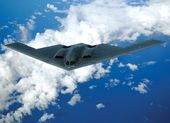
7414115528_0a461e4ff9_o
Northrop Grumman B-2 Spirit, also known as the Stealth Bomber, is an American heavy strategic bomber, featuring low observable stealth technology designed for penetrating dense anti-aircraft defenses; it is a flying wing design with a crew of two. The bomber can deploy both conventional and thermonuclear weapons, such as eighty 500 lb class (Mk 82) JDAM Global Positioning System-guided bombs, or sixteen 2,400 lb B83 nuclear bombs. The B-2 is the only acknowledged aircraft that can carry large air-to-surface standoff weapons in a stealth configuration. Twenty B-2s are in service with the United States Air Force, which plans to operate them until 2032. The B-2 is capable of all-altitude attack missions up to 50,000 feet, with a range of more than 6,000 nautical miles on internal fuel and over 10,000 nautical miles with one midair refueling. It entered service in 1997 as the second aircraft designed to have advanced stealth technology after the Lockheed F-117 Nighthawk attack aircraft. Though designed originally as primarily a nuclear bomber, the B-2 was first used in combat dropping conventional, non-nuclear ordnance in the Kosovo War in 1999. It later served in Iraq, Afghanistan, and Libya. (U.S. Air Force photo/Staff Sgt. Bennie J. Davis III)
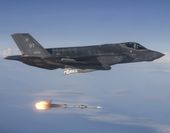
39788632113_aba4b9d2d7_o
Lockheed Martin F-35 Lightning II is a family of single-seat, single-engine, all-weather stealth multirole fighters. The fifth-generation combat aircraft is designed to perform ground-attack and air-superiority missions. It has three main models: the F-35A conventional takeoff and landing (CTOL) variant, the F-35B short take-off and vertical-landing (STOVL) variant, and the F-35C carrier-based catapult-assisted take-off but arrested recovery (CATOBAR) variant. The F-35 descends from the Lockheed Martin X-35, the winning design of the Joint Strike Fighter (JSF) program. It is built by Lockheed and many subcontractors, including Northrop Grumman, Pratt & Whitney, and BAE Systems. The United States plans to buy 2,663 F-35s, which will provide the bulk of the crewed tactical airpower of the U.S. Air Force, Navy, and Marine Corps in coming decades. Deliveries of the F-35 for the U.S. military are scheduled until 2037 with a projected service life up to 2070
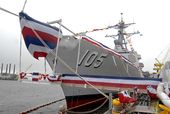
south_china_sea_06093.jpg
Jan. 26, 2008, file photo, the USS Dewey (DDG 105), a United States Navy Aegis Guided Missile Destroyer, sits at the Northrop Grumman shipyard on its christening day in Pascagoula, Miss. China is protesting a U.S. Navy patrol that brought the USS Dewey near a group of manmade islands in the South China Sea that are controlled by Beijing. The Chinese defense ministry said Thursday that it had been in contact with U.S. officials over the matter. (AP/Nicole LaCour Young, File)
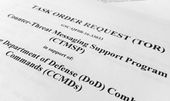
islamic_state_propaganda_war_41636.jpg
This document, photographed in Washington, on Tuesday, Jan. 17, 2017, set the government’s requirements for a $500 million contract to expand the military’s psychological operations campaign against the Islamic State and other extremist groups. Contractors allege that changes in the requirements aided the bid of the eventual winner, defense giant Northrop Grumman. (AP Photo/Jon Elswick

islamic_state_propaganda_war_60453.jpg
This document, photographed in Washington on Tuesday, Jan. 17, 2017, details the announcement of a five-year, $500 million contract awarded to Northrop Grumman on Sept. 30, 2016. The contract, for an expanded psychological operations campaign against the Islamic State and other extremist groups, is one of the largest such efforts to date. Contractors with some of Northrop Grumman’s competitors allege that a close relationship between one of the defense giant’s subcontractors and officers at Central Command gave the company an inside track on the bid. (AP Photo/Jon Elswick)
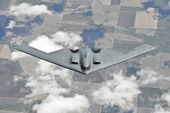
B2Spirit
Northrop Grumman B-2 Spirit Top Speed: 630 MPH The Stealth Bomber, is an American heavy penetration strategic bomber, featuring low observable stealth technology designed for penetrating dense anti-aircraft defenses; it is a flying wing design with a crew of two. The bomber can deploy both conventional and thermonuclear weapons, such as eighty 500 lb (230 kg)-class (Mk 82) JDAM Global Positioning System-guided bombs, or sixteen 2,400 lb (1,100 kg) B83 nuclear bombs. The B-2 is the only acknowledged aircraft that can carry large air-to-surface standoff weapons in a stealth configuration. (U.S. Air Force photo/Staff Sgt Jeremy M. Wilson)
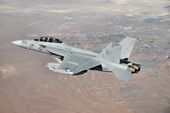
EA-18G_VX-31 2
NAVY - EA-18G GROWLER ELECTRONIC ATTACK AIRCRAFT is a carrier-based electronic warfare aircraft, a specialized version of the two-seat F/A-18F Super Hornet. The EA-18G replaced the Northrop Grumman EA-6B Prowlers in service with the United States Navy. The Growler's electronic warfare capability is primarily provided by Northrop Grumman. The EA-18G began production in 2007 and entered operational service in late 2009.
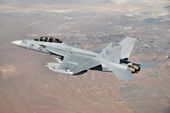
EA-18G_VX-31_over_Ridgecrest_CA_2009
EA-18G GROWLER ELECTRONIC ATTACK AIRCRAFT EA-18G Growler is a carrier-based electronic warfare aircraft, a specialized version of the two-seat F/A-18F Super Hornet. The EA-18G replaced the Northrop Grumman EA-6B Prowlers in service with the United States Navy. The Growler's electronic warfare capability is primarily provided by Northrop Grumman. The EA-18G began production in 2007 and entered operational service in late 2009.
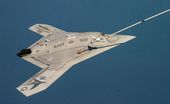
X47B
NORTHROP GRUMMAN X-47B Role: Unmanned combat air vehicle technology demonstrator Manufacturer: Northrop Grumman Status: Under development The Northrop Grumman X-47B is a demonstration unmanned combat air vehicle (UCAV) designed for aircraft carrier-based operations. Developed by the American defense technology company Northrop Grumman, the X-47 project began as part of DARPA's J-UCAS program, and subsequently became part of the United States Navy's Unmanned Combat Air System Demonstration (UCAS-D) program. The X-47B is a tailless jet-powered blended-wing-body aircraft capable of semi-autonomous operation and aerial refuelling. The X-47B first flew in 2011, and as of 2015, its two active demonstrators have undergone extensive flight and operational integration testing, having successfully performed a series of land- and carrier-based demonstrations. In August 2014, the US Navy announced that it had integrated the X-47B into carrier operations alongside manned aircraft,[6] and by May 2015 the aircraft's primary test program was declared complete. Northrop Grumman intends to develop the prototype X-47B into a battlefield-ready aircraft, the Unmanned Carrier-Launched Airborne Surveillance and Strike (UCLASS) system, which will enter service in the 2020s. The X-47B demonstrators themselves were intended to become museum exhibits after the completion of their flight testing, but the Navy later decided to maintain them in flying condition pending further development.

B2Spirit
NORTHROP GRUMMAN B-2 SPIRIT Role: Strategic stealth bomber Manufacturer: Northrop Grumman Status: In service Northrop Grumman B-2 Spirit, also known as the Stealth Bomber, is an American heavy strategic bomber, featuring low observable stealth technology designed for penetrating dense anti-aircraft defenses; it is a flying wing design with a crew of two. The bomber can deploy both conventional and thermonuclear weapons, such as eighty 500 lb-class (Mk 82) JDAM Global Positioning System-guided bombs, or sixteen 2,400 lb B83 nuclear bombs. The B-2 is the only acknowledged aircraft that can carry largeair-to-surface standoff weapons in a stealth configuration. Development originally started under the "Advanced Technology Bomber" (ATB) project during the Carter administration, and its expected performance was one of his reasons for the cancellation of the supersonic B-1A bomber. ATB continued during the Reagan administration, but worries about delays in its introduction led to the reinstatement of the B-1 program as well. Program costs rose throughout development. Designed and manufactured by Northrop Grumman, the cost of each aircraft averaged US$737 million (in 1997 dollars). Total procurement costs averaged $929 million per aircraft, which includes spare parts, equipment, retrofitting, and software support. The total program cost including development, engineering and testing, averaged $2.1 billion per aircraft in 1997. Because of its considerable capital and operating costs, the project was controversial in the U.S. Congress and among the Joint Chiefs of Staff. The winding-down of the Cold War in the latter portion of the 1980s dramatically reduced the need for the aircraft, which was designed with the intention of penetrating Soviet airspace and attacking high-value targets. During the late 1980s and 1990s, Congress slashed plans to purchase 132 bombers to 21. In 2008, a B-2 was destroyed in a crash shortly after takeoff, though the crew ejected safely. A tot
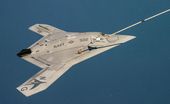
X-47B
NORTHROP GRUMMAN X-47B Role: Unmanned combat air vehicle technology demonstrator Manufacturer: Northrop Grumman Status: Under development The Northrop Grumman X-47B is a demonstration unmanned combat air vehicle (UCAV) designed for aircraft carrier-based operations. Developed by the American defense technology company Northrop Grumman, the X-47 project began as part of DARPA's J-UCAS program, and subsequently became part of the United States Navy's Unmanned Combat Air System Demonstration (UCAS-D) program. The X-47B is a tailless jet-powered blended-wing-body aircraft capable of semi-autonomous operation and aerial refuelling. The X-47B first flew in 2011, and as of 2015, its two active demonstrators have undergone extensive flight and operational integration testing, having successfully performed a series of land- and carrier-based demonstrations. In August 2014, the US Navy announced that it had integrated the X-47B into carrier operations alongside manned aircraft,[6] and by May 2015 the aircraft's primary test program was declared complete. Northrop Grumman intends to develop the prototype X-47B into a battlefield-ready aircraft, the Unmanned Carrier-Launched Airborne Surveillance and Strike (UCLASS) system, which will enter service in the 2020s. The X-47B demonstrators themselves were intended to become museum exhibits after the completion of their flight testing, but the Navy later decided to maintain them in flying condition pending further development.

B-2Spirit
The Northrop Grumman B-2 Spirit, also known as the Stealth Bomber, is an American heavy strategic bomber, featuring low observable stealth technology designed for penetrating dense anti-aircraft defenses. It is a flying wing design with a crew of two. (Northrop Grumman) ** FILE **

X-47B
NORTHROP GRUMMAN X-47B Role: Unmanned combat air vehicle technology demonstrator Manufacturer: Northrop Grumman Status: Under development The Northrop Grumman X-47B is a demonstration unmanned combat air vehicle (UCAV) designed for aircraft carrier-based operations. Developed by the American defense technology company Northrop Grumman, the X-47 project began as part of DARPA's J-UCAS program, and subsequently became part of the United States Navy's Unmanned Combat Air System Demonstration (UCAS-D) program. The X-47B is a tailless jet-powered blended-wing-body aircraft capable of semi-autonomous operation and aerial refuelling. The X-47B first flew in 2011, and as of 2015, its two active demonstrators have undergone extensive flight and operational integration testing, having successfully performed a series of land- and carrier-based demonstrations. In August 2014, the US Navy announced that it had integrated the X-47B into carrier operations alongside manned aircraft,[6] and by May 2015 the aircraft's primary test program was declared complete. Northrop Grumman intends to develop the prototype X-47B into a battlefield-ready aircraft, the Unmanned Carrier-Launched Airborne Surveillance and Strike (UCLASS) system, which will enter service in the 2020s. The X-47B demonstrators themselves were intended to become museum exhibits after the completion of their flight testing, but the Navy later decided to maintain them in flying condition pending further development.

B-2Spirit
NORTHROP GRUMMAN B-2 SPIRIT Role: Strategic stealth bomber Manufacturer: Northrop Grumman Status: In service Northrop Grumman B-2 Spirit, also known as the Stealth Bomber, is an American heavy strategic bomber, featuring low observable stealth technology designed for penetrating dense anti-aircraft defenses; it is a flying wing design with a crew of two. The bomber can deploy both conventional and thermonuclear weapons, such as eighty 500 lb-class (Mk 82) JDAM Global Positioning System-guided bombs, or sixteen 2,400 lb B83 nuclear bombs. The B-2 is the only acknowledged aircraft that can carry largeair-to-surface standoff weapons in a stealth configuration. Development originally started under the "Advanced Technology Bomber" (ATB) project during the Carter administration, and its expected performance was one of his reasons for the cancellation of the supersonic B-1A bomber. ATB continued during the Reagan administration, but worries about delays in its introduction led to the reinstatement of the B-1 program as well. Program costs rose throughout development. Designed and manufactured by Northrop Grumman, the cost of each aircraft averaged US$737 million (in 1997 dollars). Total procurement costs averaged $929 million per aircraft, which includes spare parts, equipment, retrofitting, and software support. The total program cost including development, engineering and testing, averaged $2.1 billion per aircraft in 1997. Because of its considerable capital and operating costs, the project was controversial in the U.S. Congress and among the Joint Chiefs of Staff. The winding-down of the Cold War in the latter portion of the 1980s dramatically reduced the need for the aircraft, which was designed with the intention of penetrating Soviet airspace and attacking high-value targets. During the late 1980s and 1990s, Congress slashed plans to purchase 132 bombers to 21. In 2008, a B-2 was destroyed in a crash shortly after takeoff, though the crew ejected safely. A tot
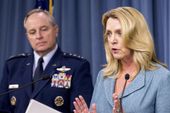
1af7faa54c420d30860f6a706700820f.jpg
Air Force Secretary Deborah Lee James, accompanied by and Air Force Chief of Staff Gen. Mark Welsh III, announces that Northrop Grumman is awarded the US Air Force’s next-generation long range strike bomber contract at a news conference at the Pentagon, Tuesday, Oct. 27, 2015. (AP Photo/Andrew Harnik)
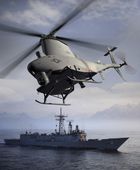
MQ-8B
NUMBER 4. MQ-8 FIRE SCOUT is an unmanned autonomous helicopter developed by Northrop Grumman for use by the United States Armed Forces. The Fire Scout is designed to provide reconnaissance, situational awareness, aerial fire support and precision targeting support for ground, air and sea forces. The initial RQ-8A version was based on the Schweizer 330, while the enhanced MQ-8B was derived from the Schweizer 333. The larger MQ-8C variant is based on the Bell 407. (Photo Illustration)

MQ-8B
NUMBER 3. MQ-8 FIRE SCOUT is an unmanned autonomous helicopter developed by Northrop Grumman for use by the United States Armed Forces. The Fire Scout is designed to provide reconnaissance, situational awareness, aerial fire support and precision targeting support for ground, air and sea forces. The initial RQ-8A version was based on the Schweizer 330, while the enhanced MQ-8B was derived from the Schweizer 333. The larger MQ-8C variant is based on the Bell 407. (Photo Illustration)


